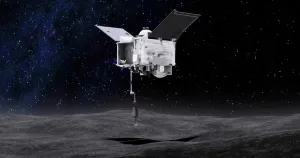
Oct 11, 2023
The Osiris-Rex Mission explained: what did we learn from it?
Launched on September 8, 2016, on ULA's Atlas V rocket, the Osiris-Rex mission dropped a capsule containing samples of a near-by asteroid nearly a month ago, on September 24th, 2023. Here’s everything you need to know.

Osiris-Rex landed on Bennu, an asteroid that is half a kilometer wide at its equator according to NASA. Due to its size and proximity to Earth, it could cause significant damage to our planet, making it one of the most dangerous celestial bodies out there. The main goal of this mission was to study how planets in our solar system were formed, and where life originated from.
Earlier today, NASA uploaded a statement saying that the 4.5 billion years old samples that they had collected, were rich in carbon and water! This is an amazing discovery, as it helps us understand the origins of life and how it was brought to Earth. Carbon and water are two building blocks of life, and their discovery on an asteroid is mind-blowing, and can give us a clearer understanding of how life
started. Water was found in the form of clay minerals, and some other components, such as iron and sulfide were also discovered. There is still a lot more studies to be conducted to truly solve all these cosmic mysteries, but this is already a promising step!

While Osiris's main objective was finished after its samples landed safely back on Earth on September 25th, Osiris isn't done yet! It has now been given an updated mission, and an updated name, Osiris-Apex. Osiris will now head to the asteroid Apophis, reaching the celestial body in 2029. Once there, Osiris will orbit the near-Earth asteroid, studying it. While it cannot collect samples, NASA plans to move closer to the surface of Apophis, and use Osiris's thrusters to kick up some of the surface material. This move will hopefully help scientists study deeper into Apophis's structure.



